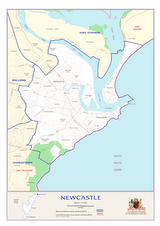Greens put greenhouse into planning approach
The Greens today launched a package to redesign the NSW planning process process for major infrastructure projects such as motorways, mining and port developments to reduce future greenhouse emissions.
Greens MP Lee Rhiannon said, "The Iemma government has major infrastructure projects on the table that will have devastating consequences for climate change if they proceed.
"Greenhouse emissions will only climb with projects like the desalination plant, the Anvil Hill coal mine, a third Newcastle coal loader, the expansion of Port Botany, a new coal fired power station and the construction of the M4 East and F6 motorways.
"These projects are the Achilles' heel of Labor's climate change talk. They make it unlikely NSW will meet even the government's modest targets for reducing greenhouse emissions.
"The Greens package would modify planning laws in NSW to ensure the vital job of reducing greenhouse gas emissions in NSW is kept firmly in view. The government can talk until its blue in the face about climate change but real action is needed to tackle it.
The 'Greenhouse Emissions Comparison' plan implements the 2006 Anvil Hill Land & Environment Court judgement and gives new functions to the NSW Greenhouse Office. It would:
* make it mandatory for proponents of a major infrastructure project, with a market value of $10 million or more, to present to the NSW Greenhouse Office for scrutiny and approval:"The Greens reforms will allow the public to scrutinise the climate change implications of major infrastructure projects and participate in the debate about the future of infrastructure and sustainability," Ms Rhiannon said.a 'Greenhouse Emissions Assessment Report' detailing the greenhouse gas implications of its projectNote: Both reports must be prepared by an independent consultant chosen by the NSW Greenhouse Office but paid for by the proponent.
a 'Greenhouse Emissions Comparison Report' that identifies alternative proposals to achieve a similar policy outcome (for example if the development was a coal mine then options such as investing in developing renewable energy manufacturing industries like wind or solar thermal electric power technologies would be identified, and their respective greenhouse gas implications compared);
* require that both the 'Greenhouse Emissions Assessment Report' and the 'Greenhouse Emissions Comparison Report' be included in the environmental assessment documents released for public consultation as part of the approval process;
* require that the Department of Planning assess the climate change implications of the proposed major project, the public's response to the project and the alternatives canvassed; and
* require the Minister for Planning to reject the proponent's proposal if it is forecast to create more than 10% higher greenhouse emissions than any of the identified alternatives.
Background to the Greenhouse Emissions Comparison Package
The package is designed to reduce greenhouse gas emissions in NSW through an overhaul of the NSW planning process for major infrastructure projects such as motorways, mining and port developments.
The package implements the 2006 NSW Land & Environment Court's Anvil Hill decision which supports a detailed greenhouse gas assessment as part of the approval process for all major projects.
This is in line with processes in WA and the NT where government guidelines require developers to include an assessment of the greenhouse gas implications of major developments in environmental impact statements.
The Greens package goes a step further by requiring the identification of alternative lower emission projects that could achieve the same policy aim as the proposal under consideration.
Former Premier Bob Carr established the NSW Greenhouse Office in 2004 and charged it with responsibility for spearheading policy to combat climate change.
The Office has concentrated on greenhouse measures which really should be tackled federally, such as emissions trading.
As a result NSW government agencies have been left unchecked to pursue projects like the desalination plant, a new coal fired power station and motorways that lock NSW into massive increases in emissions.
In February 2007 Dr Tim Flannery, Australian of the Year, told the ABC's Stateline that "if you look at emissions for the State [NSW], year after year, they've relentlessly risen, and that's a sign of failure."
Giving the Greenhouse Office new functions to scrutinise the climate change implications of major projects and alternative, sustainable visions would go some way to increasing its contribution to reducing emissions in NSW.




